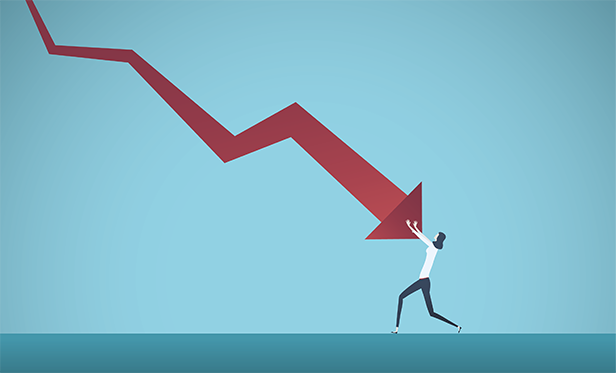
History has taught us that insolvencies act like the canary inthe coal mine: Their rise typically precedes a recession. 2019marks an inflection point of rising insolvencies in developedmarkets around the world, with Atradius economists predicting an increase ofnearly 3 percent in 2019 and 1.2 percent in 2020. But this time,it's not clear what the trend might foretell. Some of the majorfactors contributing to the current insolvency increase—notably,uncertainty over trade policy and Brexit—could be corrected duringthe next few months.
|What is clear is that these are uncertain times, as businessleaders everywhere anxiously await the next round of tariffs in theeconomic tit-for-tat between the United States andChina. Brexit is another source of worry, as it'sanyone's guess at this point how the final decision will playout.
|Uncertainty is bad for business because itmakes planning for the future difficult, leading executives todelay investments. This results in a self-inflicted spiral asbusinesses hold off on investments because of volatility, whichleads to slower growth, higher unemployment, and increasedinsolvency activity—and then the process repeats.
||
U.S. Set to See Highest Increase in Insolvencies
Among developed markets tracked by Atradius economists, theUnited States is predicted to see the largest increase in corporateinsolvencies, with a forecasted rise of 3.2 percent in 2019 andanother 2 percent in 2020. The U.S.'s central role in global tradepolicy uncertainty is one factor in this outlook, as are highlevels of corporate debt, the dollar's strong position, and theunwinding of the pro-cyclical fiscal policy. In addition, factory output is on the decline and consumer confidence is down.
|The retail sector is particularly hurting, with more than 12,000 stores expected to close in2019. The U.S.-China trade war has been a major challenge, as manyretailers source goods from China and are now getting hit withprice increases. The latest escalation, forinstance, included a 15 percent tariff on $300 billion of consumergoods from China that will go into effect next year. E-commerce isanother problem, as many smaller retailers struggle to competeagainst giants like Amazon.
|The U.S. agricultural industry is also struggling. U.S. farmbankruptcy filings rose 13 percent this year (as of July), asix-year high. Bad weather and retaliatory tariffs targetingagricultural products are contributing factors. Farm insolvencieshave far-reaching implications for other players in the space, suchas durable goods, machinery, and fertilizer companies.
||
Brexit Causes Insolvency Jump in Western Europe
Western Europe is forecasted to see the second-highest increasein insolvencies this year, with a predicted 2.7 percent increase in2019. Slowing economic growth and lower global trade are twocontributing factors, but widespread uncertainty surrounding Brexitis the major culprit there.
|The United Kingdom is expected to see a 10 percent increase ininsolvencies in 2019 and another 5 percent in 2020, which is thelargest jump among Western European nations. Brexit remains anunpredictable and intractable mess. The continued deferment of theU.K.'s departure from the European Union (EU) has prevented therecovery of the pound sterling, kept inflation high, anddiscouraged businesses from making key investments. If the U.K.cannot execute a smooth transition out of the EU in the first halfof 2020, and the period of uncertainty drags on, insolvencies couldincrease beyond this prediction. The turmoil isn't contained to theU.K., as many EU countries have close trading relationships withthe U.K.
|Switzerland, another big contributor to Western Europe'sincrease in insolvencies, is forecasted to see a 4 percent jump in2019. Swiss insolvencies have been on the rise since 2015,following the Eurozone debt crisis and the scrapping of the Swissfranc's ceiling against the euro. Global trade uncertainty plays arole; the Swiss franc is a safe-haven currency and demand is up.The construction and hospitality sectors will likely bear the bruntof Swiss insolvencies.
||
A Silver Lining
A recession could very well be on its way, but there are a fewreasons for hope. For one, geopolitical issues are causing the mostuncertainty at the moment, so they also provide an obvious pathtoward solving the problem. A resolution to the U.S.-China tradewar and a smooth conclusion to the Brexit crisis would be positivefor global growth, which would encourage business investments andprevent further insolvencies.
|The Federal Reserve recently cut the target federal funds rateanother 25 basis points (bps). Monetary policy typically takesbetween six months and a year to work through the system, so in thenear future, the recent cut cycle should provide positive economicstimulus. The Fed also signaled they are pausing at the currentinterest rate levels as they observe the impact. Monetary or fiscalpolicy that is more accommodative than expected would also helpstimulate growth and reduce insolvency expectations.
|Another reason for hope is that the forecasted increase ininsolvencies in the U.S. is not as dire as it may seem on thesurface. In 2007, ahead of the Great Recession, insolvencies rose15 to 20 percent. That's significantly higher than the 3.2 percentincrease expected for this year. Plus, the U.S. has accommodativebankruptcy laws compared with other developed markets, making iteasy for companies to enter Chapter 11. In other markets, aninsolvency means the business liquidates. In the U.S., it oftenrepresents a period of course-correcting for an organization thatwill continue to operate.
|That said, however, the insolvencies trend certainly indicatessome risks to global businesses. Corporate treasury and financeleaders should become knowledgeable about local legal rules andregulations so that they are prepared in the event that a tradingpartner goes bankrupt. Another option is trade credit insurance,which can protect an organization against delayed or missingpayments and can also help companies navigate complex bankruptcylaws.
|
 Aaron Rutstein isvice president and director of risk services, Americas forAtradius TradeCredit Insurance, Inc. With more than a decade ofexperience in the trade credit insurance industry, Rutstein hasdeveloped expertise in business development, risk analysis, andbuyer monitoring.
Aaron Rutstein isvice president and director of risk services, Americas forAtradius TradeCredit Insurance, Inc. With more than a decade ofexperience in the trade credit insurance industry, Rutstein hasdeveloped expertise in business development, risk analysis, andbuyer monitoring.
Complete your profile to continue reading and get FREE access to Treasury & Risk, part of your ALM digital membership.
Your access to unlimited Treasury & Risk content isn’t changing.
Once you are an ALM digital member, you’ll receive:
- Critical Treasury & Risk information including in-depth analysis of treasury and finance best practices, case studies with corporate innovators, informative newsletters, educational webcasts and videos, and resources from industry leaders.
- Exclusive discounts on ALM and Treasury & Risk events.
- Access to other award-winning ALM websites including PropertyCasualty360.com and Law.com.
*May exclude premium content
Already have an account? Sign In
© 2024 ALM Global, LLC, All Rights Reserved. Request academic re-use from www.copyright.com. All other uses, submit a request to [email protected]. For more information visit Asset & Logo Licensing.








